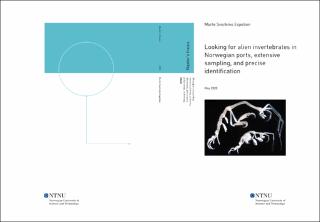| dc.description.abstract | Fremmedarter er sammen med klimaendringer, tap av habitat, overhøsting og forurensning de mest alvorlige truslene globalt mot biologisk mangfold. I det marine miljø spres arter blant annet gjennom internasjonal skipstrafikk og introduksjoner for akvakultur. Et viktig steg for å kunne effektivt forvalte fremmedarter er å overvåke områder som er spesielt sårbare for å motta nye arter. Kommersielle havner som mottar internasjonal skipsfart, og småbåthavner hvor fritidsfartøy kan bidra til sekundærspredning er eksempler på områder som bør overvåkes for tidlig oppdagelse av nyankomne fremmedarter. I denne studien ble forekomst av 21 fremmede marine virvelløse dyr undersøkt. Prøver ble tatt i 22 havner langs kysten mellom Trondheim og Oslo. Internasjonale havner i dette området ble undersøkt med metoder fra HELCOM/OSPAR protokollen for havneundersøkelser. Småbåthavnene ble studert etter Rapid Coastal Survey metodikk. Fremmedarter ble funnet på alle de undersøkte stedene. Det ble funnet flere fremmede arter i den sørlige delen av studieområdet enn lenger nord. Fire fremmedarter ble funnet, spøkelseskrepsen Caprella mutica, ruren Amphibalanus improvisus, muslingen Crassostrea gigas og sekkedyret Styela clava. Alle disse artene er allerede kjent fra norske farvann. Ingen dørstokkarter, arter som er etablert i naboland eller forventet å komme til norske kystområder innen 50 år, ble funnet. Presis artsbestemmelse er viktig i arbeidet med å overvåke fremmedarter. I denne studien ble det lagd bestemmelsesverktøy for de artene som ble funnet. Bestemmelsesverktøyene har spesielt søkelys på å skille fremmedartene fra hjemmehørende forvekslingsarter. En bestemmelsesnøkkel for vanlige spøkelseskreps i norske farvann ble også utviklet. | |
| dc.description.abstract | Alien species, together with climate change, habitat loss to land and sea use, overexploitation and pollution are the major threats to biodiversity globally. In the marine environment, species are spread through different pathways, international shipping and aquaculture being some of these. One important step in managing alien species is to monitor areas susceptible to receive alien species for early detection. Such areas are, among others, commercial harbors that receive international shipping and marinas where recreational crafts may contribute to secondary spread of species. In this study, the occurrence of 21 alien marine invertebrates were investigated in 22 harbors and marinas along the coast between Trondheim and Oslo. International harbors along the coast between Trondheim and Oslo were surveyed following sampling procedures from the HELCOM/OSPAR sampling protocol. Marinas for recreational crafts in the same area were sampled with a Rapid Coastal Survey approach. Alien species were found in all surveyed sites. More alien species was found in the southern part of the study area than further north. Four species, the amphipod Caprella mutica, the cirriped Amphibalanus improvisus, the bivalve Crassostrea gigas and the ascidian Styela clava, were recorded. All the species found are already known to be established in Norwegian waters, no doorknockers, species that are established in neighboring countries or expected to establish in Norway within 50 years, were found. Correct species identification is crucial for monitoring of alien species. Tools to aid precise identification are provided for the four species found in this study, with special regard to distinguishing the alien species from native congruences. Identification sheets for these species are provided. An identification key for commonly found caprellids in Norwegian waters was developed. | |
